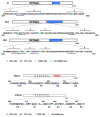CK1 in Developmental Signaling: Hedgehog and Wnt
- PMID: 28236970
- PMCID: PMC5837819
- DOI: 10.1016/bs.ctdb.2016.09.002
CK1 in Developmental Signaling: Hedgehog and Wnt
Abstract
The casein kinase 1 (CK1) family of serine (Ser)/threonine (Thr) protein kinases participates in a myriad of cellular processes including developmental signaling. Hedgehog (Hh) and Wnt pathways are two major and evolutionarily conserved signaling pathways that control embryonic development and adult tissue homeostasis. Deregulation of these pathways leads to many human disorders including birth defects and cancer. Here, I review the role of CK1 in the regulation of Hh and Wnt signal transduction cascades from the membrane reception systems to the transcriptional effectors. In both Hh and Wnt pathways, multiple CK1 family members regulate signal transduction at several levels of the pathways and play either positive or negative roles depending on the signaling status, individual CK1 isoforms involved, and the specific substrates they phosphorylate. A common mechanism underlying the control of CK1-mediated phosphorylation of Hh and Wnt pathway components is the regulation of CK1/substrate interaction within large protein complexes. I will highlight this feature in the context of Hh signaling and draw interesting parallels between the Hh and Wnt pathways.
Keywords: CK1; Cancer; Development; GSK3; Hh; Kinase; PKA; Phosphorylation; Signaling; Smo; Wnt; β-Catenin.
© 2017 Elsevier Inc. All rights reserved.
Figures




Similar articles
-
Casein kinase 1 and Wnt/β-catenin signaling.Curr Opin Cell Biol. 2014 Dec;31:46-55. doi: 10.1016/j.ceb.2014.08.003. Epub 2014 Sep 15. Curr Opin Cell Biol. 2014. PMID: 25200911 Review.
-
The casein kinase 1 family: participation in multiple cellular processes in eukaryotes.Cell Signal. 2005 Jun;17(6):675-89. doi: 10.1016/j.cellsig.2004.12.011. Epub 2005 Jan 25. Cell Signal. 2005. PMID: 15722192 Review.
-
CKI, there's more than one: casein kinase I family members in Wnt and Hedgehog signaling.Genes Dev. 2006 Feb 15;20(4):399-410. doi: 10.1101/gad.1394306. Genes Dev. 2006. PMID: 16481469 Review.
-
Casein kinase 1 gamma couples Wnt receptor activation to cytoplasmic signal transduction.Nature. 2005 Dec 8;438(7069):867-72. doi: 10.1038/nature04170. Nature. 2005. PMID: 16341016
-
The role of the casein kinase 1 (CK1) family in different signaling pathways linked to cancer development.Onkologie. 2005 Oct;28(10):508-14. doi: 10.1159/000087137. Epub 2005 Sep 19. Onkologie. 2005. PMID: 16186692 Review.
Cited by
-
Longdaysin inhibits Wnt/β-catenin signaling and exhibits antitumor activity against breast cancer.Onco Targets Ther. 2019 Feb 5;12:993-1005. doi: 10.2147/OTT.S193024. eCollection 2019. Onco Targets Ther. 2019. PMID: 30787621 Free PMC article.
-
CRISPR-mediated gene targeting of CK1δ/ε leads to enhanced understanding of their role in endocytosis via phosphoregulation of GAPVD1.Sci Rep. 2020 Apr 22;10(1):6797. doi: 10.1038/s41598-020-63669-2. Sci Rep. 2020. PMID: 32321936 Free PMC article.
-
CHMP2B regulates TDP-43 phosphorylation and cytotoxicity independent of autophagy via CK1.J Cell Biol. 2022 Jan 3;221(1):e202103033. doi: 10.1083/jcb.202103033. Epub 2021 Nov 2. J Cell Biol. 2022. PMID: 34726688 Free PMC article.
-
A Rationale for Drug Design Provided by Co-Crystal Structure of IC261 in Complex with Tubulin.Molecules. 2021 Feb 10;26(4):946. doi: 10.3390/molecules26040946. Molecules. 2021. PMID: 33579052 Free PMC article.
-
The CK1ε/SIAH1 axis regulates AXIN1 stability in colorectal cancer cells.Mol Oncol. 2024 Sep;18(9):2277-2297. doi: 10.1002/1878-0261.13624. Epub 2024 Feb 28. Mol Oncol. 2024. PMID: 38419282 Free PMC article.
References
-
- Apionishev S, Katanayeva NM, Marks SA, Kalderon D, Tomlinson A. Drosophila Smoothened phosphorylation sites essential for Hedgehog signal transduction. Nat Cell Biol. 2005;7:86–92. - PubMed
-
- Aza-Blanc P, Ramirez-Weber F, Laget M, Schwartz C, Kornberg T. Proteolysis that is inhibited by Hedgehog targets Cubitus interruptus protein to the nucleus and converts it to a repressor. Cell. 1997;89:1043–53. - PubMed
-
- Basler K, Struhl G. Compartment boundaries and the control of Drosophila limb pattern by hedgehog protein. Nature. 1994;368:208–14. - PubMed
-
- Bhatia N, Thiyagarajan S, Elcheva I, Saleem M, Dlugosz A, Mukhtar H, Spiegelman VS. Gli2 is targeted for ubiquitination and degradation by beta-TrCP ubiquitin ligase. The Journal of biological chemistry. 2006;281:19320–6. - PubMed
Publication types
MeSH terms
Substances
Grants and funding
LinkOut - more resources
Full Text Sources
Other Literature Sources
Research Materials
Miscellaneous

